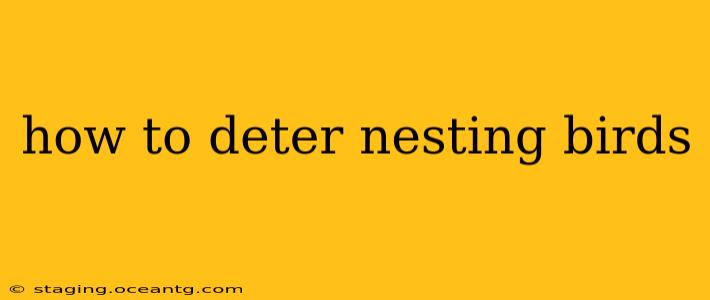Birds nesting on your property can be a delightful experience, offering a glimpse into the natural world. However, sometimes their chosen nesting location presents challenges. Whether it's a messy situation under a porch, concerns about droppings damaging your car, or safety issues near electrical wiring, knowing how to deter birds humanely and effectively is crucial. This guide provides practical solutions to manage bird nesting without harming the birds or their young.
Why Are Birds Nesting Here?
Before exploring deterrents, it's important to understand why birds choose your property. They're looking for shelter, safety from predators, and ample access to food and water. Common nesting sites include eaves, ledges, chimneys, and trees. Identifying what attracts birds to your specific location helps you tailor your deterrent strategy.
What are some humane ways to deter birds from nesting?
This is a key question, and the answer focuses on making the area less appealing without harming the birds. We'll explore various methods, emphasizing humane and effective solutions.
1. Physical Barriers:
This is often the most effective method, focusing on physically preventing birds from accessing the desired nesting area.
- Netting: Use netting specifically designed for bird deterrents. Ensure it has a sufficiently large mesh size to prevent birds from becoming entangled. It's crucial to install it correctly and securely to avoid injury. This is a good option for areas like eaves or under porches.
- Spikes: Bird spikes are designed to prevent birds from landing on ledges or surfaces. They are effective but need to be installed carefully and are not appropriate for all areas.
- Scare Tacks: These are small, pointed devices that create an uncomfortable surface for birds to land on. They are less visually obtrusive than spikes.
- Blocking access points: Simply closing off or covering access points to potential nesting sites can often be enough.
2. Visual and Auditory Deterrents:
These methods aim to scare birds away without causing direct harm.
- Shiny objects: Hanging shiny objects like ribbons, Mylar balloons, or reflective tape can deter birds with their movement and glare. The movement is key; static objects are usually ignored.
- Predatory decoys: Placing fake owls, hawks, or snakes can create a sense of threat, but their effectiveness diminishes over time as birds become accustomed to them. Rotate their placement for better results.
- Ultrasonic devices: These devices emit high-frequency sounds that are unpleasant to birds but generally inaudible to humans. Their effectiveness varies, and some birds may adapt to the sounds.
3. Removing Attractants:
Often, birds are attracted to readily available food and water sources. Removing these attractants can reduce their interest in your property.
- Clean up food sources: Remove fallen fruit, spilled seeds, or accessible garbage. Keep pet food indoors or in secured containers.
- Reduce water sources: Eliminate standing water in birdbaths, containers, or clogged gutters, especially during nesting season.
What if birds have already started building a nest?
If birds have already begun building a nest, it's generally best to wait until the young have fledged (left the nest). Removing a nest with eggs or young birds is illegal in many areas and is inhumane. Once the birds have left, you can implement the preventative measures mentioned above to discourage future nesting.
Are there any natural deterrents?
Several natural methods exist, although their effectiveness can vary.
- Strong-smelling plants: Some plants have strong scents that birds dislike, such as peppermint, lavender, or rosemary. However, the effectiveness of this method is debated.
- Citrus peels: Scattered citrus peels may also deter birds temporarily.
When is the best time to deter birds?
Ideally, you should implement deterrents before birds begin nesting in the spring. This prevents the birds from establishing a nest in the first place.
By implementing a combination of these humane and effective methods, you can successfully manage bird nesting on your property while ensuring the well-being of the birds. Remember to always prioritize humane and legal solutions.
